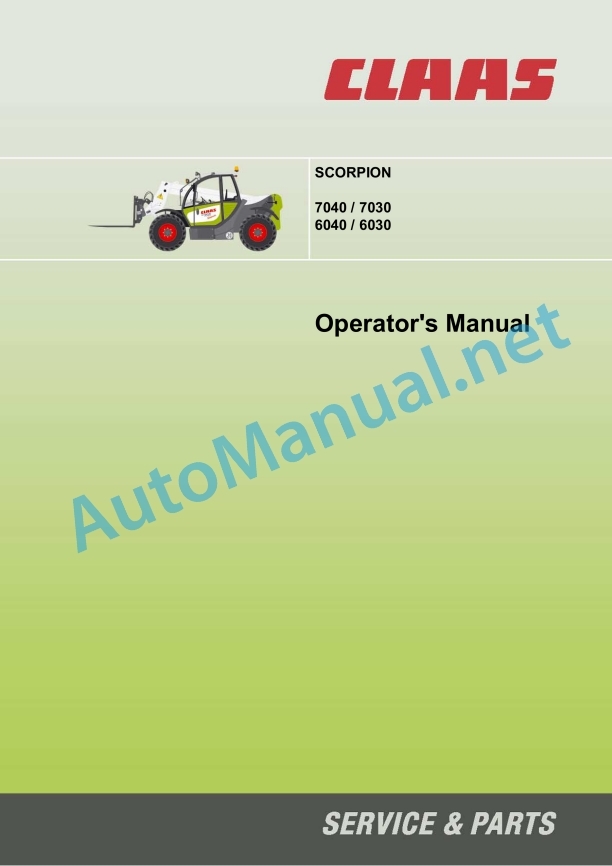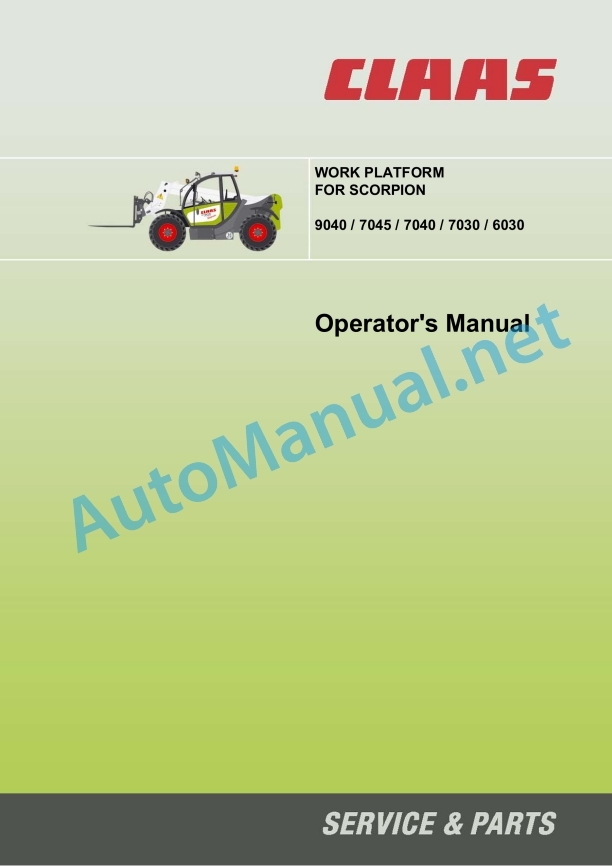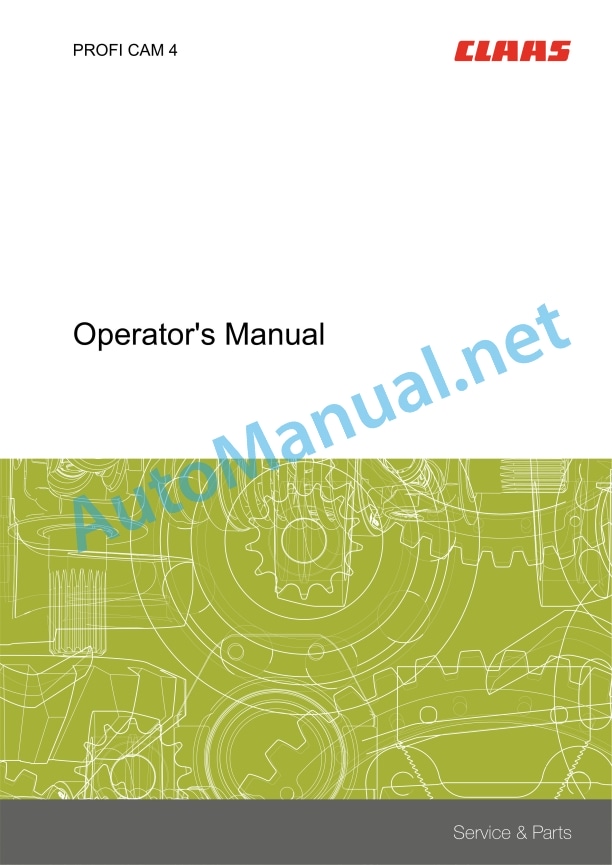Claas Scorpion 6040 (K03) Telehandlers Operator Manual EN
$50.00
- Model: Scorpion 6040 (K03) Telehandlers
- Type Of Manual: Operator Manual
- Language: EN
- Format: PDF(s)
- Size: 21.5 MB
File List:
00 0290 037 0.pdf
00 0293 934 2.pdf
00 0295 114 1.pdf
00 0301 051 0.pdf
00 0303 482 0.pdf
00 0293 934 2.pdf:
Operator’s Manual
Table of contents
1 Introduction
1.1 Important information on this Operator’s Manual
Abbreviations/symbols
1.2 Machine overview
1.3 Brief description
Hydrostatic drive
Work hydraulics and 4 wheel steering
Cooling system
1.4 Fields of application
1.5 Model designation – trade names
1.6 Use: implement
1.7 Regulations
Driving licences
Equipment
Machine inspections
Documents
Warning identification of the machine
1.8 EC declaration of conformity model 400-01
1.9 EC declaration of conformity model 401-01
1.10 EC declaration of conformity model 402-01
1.11 EC declaration of conformity model 403-01
1.12 Type labels and component numbers
Serial number
Cab number
Engine number
Hydraulic pump number
Variable displacement motor number
Variable displacement motor number (high speed option)
Front and rear axle numbers
1.13 Signs and symbols
Labels on the outside of the machine
Labels on the inside of the machine
2 Safety instructions
2.1 Identification of warnings and dangers
2.2 Warranty
2.3 Designated use and exemption from liability
2.4 General conduct and safety instructions
Organisational measures
Selection and qualification of staff, basic responsibilities
2.5 Safety instructions regarding operation
Normal operation
Applications with lifting gear
Trailers and implements
Transport
2.6 Safety instructions for maintenance
Service and maintenance work on ROPS/FOPS superstructures (ROPS bar)
2.7 Warning of special hazards
Electric energy
Gas, dust, steam, smoke
Hydraulic equipment
Oil, grease and other chemical substances
3 Operation
3.1 Overview of control elements
3.2 Cab overview
3.3 Instrument panel, multifunctional lever, switch consoles: overview
3.4 Telltales and warning lights: description
Telltale and warning light – instru ment panel
Telltale and warning light – instru ment panel
3.5 Taking the machine into service for the first time
Safety instructions
Important information
Running-in period
Check lists
Start-up checklist
Operation checklist
Parking checklist
Opening the door from the outside and inside
Side window
Rear window
3.7 Rear window emergency exit
3.8 Electric mirror adjustment (option)
3.9 Starting the engine
Before starting the engine
Starting the engine
3.10 Drive interlock with transponder key (option)
Disabling (releasing the drive interlock)
Enabling (locking the drive interlock)
3.11 Key-based drive interlock (option)
Disabling (releasing) the drive interlock
Enabling (locking) the drive interlock
Oil and fuel preheater (option)
3.12 Jump-starting the engine (external battery)
Safety instructions
Procedure
3.13 Before moving off
Special instructions for driving on public roads
Locking the control lever (joystick) and the 3rd control circuit (implements)
Steering column height and angle adjustment
Checking the steering system
Synchronous wheel position
Adjusting the height of the control lever base
Accelerator pedal
Brake/inching pedal
Parking brake
3.14 Moving off
Changing direction (forwards/reverse)
Selecting the speed range 0 – 20 kph
Selecting the drive range 0 – 30/40 kph (option)
Crawler gear potentiometer (option)
3.15 Load stabiliser
3.16 Backup warning system (option)
3.17 Differential lock
3.18 Synchronising the steering system
3.19 Changing steering mode
Front wheel steering
4 wheel steering
Changing over to diagonal steering (crab steering option)
3.20 Stopping/parking the machine
3.21 Light system
Headlights
Working light
Interior light
3.22 Signalling system
Turn indicator
Hazard warning system
Rotating beacon (option)
3.23 Cab heating and ventilation
3.24 Air conditioning (option)
3.25 Washer system
Tank for washer system
3.26 Seat
Seat adjustment
Weight adjustment
Backrest adjustment
Longitudinal adjustment with control lever base (option)
Horizontal adjustment without control lever base
3.27 Seat belt (lap belt)
Fastening the seat belt:
Unfastening the seat belt:
Longer/shorter lap belt adjustment:
3.28 Engine cover
3.29 Fire extinguisher (option)
3.30 Battery master switch (option)
3.31 Reversing cooling fan (option)
3.32 Towing and transporting the machine
Getting ready for towing
Towing the machine
3.33 Loading and transporting the telehandler
Safety instructions
Loading the machine
Strapping down the machine
3.34 Crane handling the machine
Safety instructions
Crane handling
3.35 Telescopic boom operation: overview
Operating the control lever for the lift, tilt and push-out rams
Operation of 3rd control circuit
3.36 Operating the telescopic boom
General safety instructions
Safe load indicator
Safe load indicator display
Functional check of the safe load indicator
Raising/extending the telescopic boom
Retracting/lowering the telescopic boom
3.37 Re-equipping implements
Picking up an implement with the hydraulic quickhitch facility
Re-equipping implements on the hydraulic quickhitch
Fitting an implement onto the mechanical quickhitch facility (option)
3.38 Safety feature “Hose burst valve”
3.39 Mounting/removing the pallet forks
Picking up the pallet forks
Removing the pallet forks from the quickhitaty
Driving on public roads with the pallet forks
3.40 Adjusting the fork arms
3.41 Working with the pallet forks
General safety instructions
Brief instructions for fork arms
Specific safety instructions
Load diagram for pallet forks (EN 1459/1998)
Bucket payloads
Approaching the material
Loading the material
Picking up material and setting it down in a high position
3.42 Working with the standard bucket
General instructions
Practical hints for digging
Tilt position of the bucket
Transport position of the bucket
Transporting with a full bucket
Loading loose material
Loading if the material is hard to penetrate
Removing material/digging in soft soil
Removing material/digging in hard soil
Loading vehicles
Freeing the machine
3.43 Mounting/removing the multipurpose bucket
Pressure relief on the quick couplers and the quickhitch facility
Hydraulic connections: telehandler – multipurpose bucket
Removing the multipurpose bucket from the quickhitch facility
3.44 Working with the multipurpose bucket
Driving on public roads with the multipurpose bucket
Grading and scraping
Stripping in thin layers (scraper)
Spreading material in layers
Pulling out material from slopes
Moving material with longer reach
Picking up residual material in grab operation
Grabbing bulky material
Grabbing large objects
Pulling out and setting posts
Precise unloading in grab operation
Backfilling round gravel into drainage ditches
Unloading from the bottom of the bucket for increased dump heights
3.45 Working with a crane jib (option)
3.46 Continuous operation of 3rd control circuit (option)
3.47 Changeover: 3rd control circuit to additional front control circuit (option)
3.48 Operation: front/rear additional hydraulic control circuit (option)
3.49 Tipping trailer operation (option)
3.50 Connection of electrically operated implements (option)
3.51 Operation of the Autohitch trailer coupling (option)
3.52 Trailer coupling operation (option)
3.53 Compressed-air brake system (option)
General safety instructions
Coupling and uncoupling com pressed-air hoses (dual-circuit brake system)
Compressed-air gauge
3.54 Hydraulic trailer brake connection (option)
4 Troubleshooting
4.1 Engine trouble
4.2 Malfunctions in the air conditioning system (option)
5 Maintenance
5.1 Introduction
5.2 Safety prop for telescopic boom
5.3 Fuel system
Specific safety instructions
Refuelling
Stationary fuel pumps
Diesel fuel specification
Checking/replacing the fuel prefilter (water separator)
Replacing the fuel filter
Bleeding the fuel system
5.4 Engine lubrication system
Checking the engine oil level
Filling up engine oil
Replacing the engine oil every 500 s/h (service hours)
Replacing the engine oil filter car tridge every 500 s/h (service hours)
5.5 Engine and hydraulics cooling system
Specific safety instructions
Checking the coolant level and quality
Filling up coolant
Draining coolant
Cleaning the radiator fins
Cleaning the radiator with the reversing fan (option)
5.6 Air filter
Checking air filter contamination
Replacing the filter cartridge at 500 s/ h (service hours)
5.7 V-belt
5.8 Hydraulic system
Specific safety instructions
Monitoring the hydraulic oil and the reflux filter
Checking the hydraulic oil level once a day
Filling up the hydraulic oil
Important information for the use of biodegradable oil
5.9 Checking hydraulic pressure lines
Specific safety instructions
5.10 Lubrication work
Central lubrication system (option)
General safety instructions
Lubricating the rear axle oscillation- type bearing
Lubricating the planetary drive bearing
Lubrication points on the telescopic boom: overview
Lubricating the telescopic boom
Checking and adjusting the wear plates
5.11 Maintenance of the brake system
Specific safety instructions
Checking/filling up the brake fluid level
5.12 Maintenance: compressed-air brake system (option)
Checking the compressed-air tank and lines
Checking compressor attachment and drive
5.13 Tyres
Daily tyre checks
Changing wheels
5.14 Heating – fresh air
Cleaning/replacing the fine-dust filter
Cleaning/replacing the recirculated-air filter
5.15 Air conditioning (option): maintenance
General safety instructions
Functional and visual check once a day
5.16 Maintenance of the electric system
Specific safety instructions
Service and maintenance work at regular intervals
Cables, bulbs and fuses
Alternator
Adjusting the headlights
Checking/replacing the battery
5.17 Maintenance: trailer coupling
Trailer coupling (option)
5.18 General maintenance work
Specific safety instructions
When using washing solvents
When using compressed air
When using a high-pressure cleaner or steam jet
When using volatile and easily flam mable anticorrosion agents and sprays
Cleaning inside the cab
Cleaning the seat belt
Cleaning the exterior of the machine
Cleaning the engine and the engine compartment
Screw connections
Pivots and hinges
5.19 Maintenance if the machine is used in a saline environment
Aggressive media (option)
5.20 Maintenance and service of the implements
5.21 Fluids and lubricants
5.22 Maintenance plan (overview)
5.23 Maintenance label
Explanation of symbols on mainte nance label
6 Specifications
6.1 Model and trade names: overview
6.2 Frame
6.3 Engine
6.4 Oil/water cooling fan
6.5 Power train
Variable displacement pump
Variable displacement motor
6.6 Axles
Front axle
Rear axle
6.7 Service and parking brake
6.8 Steering system
6.9 Work hydraulics
Hydraulic pump
Hydraulic ram protection
Lift, tilt and push-out rams: velocity
Hydraulic pilot control
Additional control circuit (option)
6.10 Electric system
Fuses: overview
Electric components
Main fuse box with relays
Relays: overview
6.11 Tyres for models 400-01/401-01
6.12 Tyres for models 402-01/403-01
6.13 Weights
6.14 Noise levels
6.15 Vibration
6.16 Coolant compound table
6.17 Tightening torques
General tightening torques
Specific tightening torques
6.18 Trailer couplings: trailer weight/drawbar load
6.19 Payload: load diagram up to serial no. 400 01 0033
6.20 Payload: load diagram starting serial no. 400 01 0034
6.21 Payload: load diagram up to serial no. 401 01 0046
6.22 Payload: load diagram starting serial no. 401 01 0047
6.23 Payload: load diagram starting serial no. 402 01 0001
6.24 Payload: load diagram up to serial no. 403 01 0015
6.25 Payload: load diagram starting serial no. 403 01 0016
6.26 Dimensions with bucket
6.27 Dimensions with pallet forks
00 0295 114 1.pdf:
Operator’s Manual
Table of contents
EC Declaration of Conformity
1 Introduction
1.1 Important information on this Operator’s Manual
1.2 Fields of application and work platform operation
1.3 Safety instructions regarding work platform operation
1.4 Driving on public roads with the work platform
1.5 Necessary machine equipment for work platform operation
1.6 Work platform type label
1.7 Warranty – work platform
2 Safety instructions
2.1 Identification of warnings and dangers
2.2 Designated use and exemption from liability
2.3 General conduct and safety instructions
2.4 Safety instructions regarding work platform operation
2.5 Lifting gear applications
2.6 Transporting the work platform
2.7 Safety instructions regarding work platfm mainnance
2.8 Warning of special hazards with the work platform
3 Installing and taking the work platform into service
3.1 Brief description of work platform
3.2 Work platform design
3.3 Picking up a work platform with the quickhitch
3.4 Preparing the work platform for operation
3.5 Radio control system (transmitter) operation
3.6 Overview of transmitter and receiver system control elements
3.7 “STOP switch” safety feature on the transmitter
3.8 Indications regarding the transmitter battery
3.9 Putting the transmitter into operation
3.10 Emergency lowering of the telescopic boom
3.11 Removing the work platform from the quickhitch
4 Maintenance and specifications
4.1 Maintenance work on the work platform
4.2 Maintenance work on the transmitter and receiver system
4.3 Charging the transmitter battery
4.4 Troubleshooting the transmitter and receiver system
4.5 Transmitter and receiver system specifications
4.6 List of frequencies for radio control system
4.7 Worktform spications
4.8 Inspection and maintenance work report
00 0301 051 0.pdf:
PROFI CAM 3
Table of contents
1 Introduction
1.1 Notes on the manual
1.1.1 Validity of manual
1.1.2 Information about this Operator’s Manual
1.1.3 Symbols and notes
1.1.4 Optional equipment
1.1.5 Qualified specialist workshop
1.1.6 Maintenance information
1.1.7 Warranty notes
1.1.8 Spare parts and technical questions
1.2 Intended use
1.2.1 Intended use
1.2.2 Reasonably foreseeable misuse
2 Safety
2.1 Identifying warnings
2.1.1 Hazard signs
2.1.2 Signal word
2.2 Safety rules
2.2.1 Meaning of Operator’s Manual
2.2.2 Observing safety decals and warnings
2.2.3 Optional equipment and spare parts
3 Product description
3.1 Overview and method of operation
3.1.1 How the PROFI CAM works
3.2 Identification plates and identification number
3.2.1 Position of identification plates
3.2.2 Explanation of PROFI CAM identification plate
3.3 Information on the product
3.3.1 CE marking
4 Operating and control elements
4.1 Camera system
4.1.1 Camera system monitor
4.2 Menu structure
4.2.1 Main menu
4.2.2
4.2.3
4.2.4
4.2.5
4.2.6
5 Technical specifications
5.1 PROFI CAM
5.1.1 Monitor
5.1.2 Camera
5.1.3 Switch box
5.1.4 Degree of protection against foreign bodies and water
6 Preparing the product
6.1 Shutting down and securing the machine
6.1.1 Switching off and securing the machine
6.2 Prior to operation
6.2.1 Carry out prior to operation
6.2.2 Installing the sun protection
6.2.3 Aligning the camera
6.2.4 Connecting the camera electrics
7 Operation
7.1 Monitor
7.1.1 Switching on the monitor
7.1.2 Calling up the menu
7.1.3 Setting a menu item
7.1.4 Setting the image orientation
7.1.5 Setting automatic screen darkening
7.1.6 Image mirroring
7.1.7 Setting the trigger view
7.1.8 Setting the follow-up time for trigger view
7.1.9 Setting the display mode
7.1.10 Activating/deactivating a display mode
8 Faults and remedies
8.1 Electrical and electronic system
8.1.1 Overview of problems on PROFI CAM camera system
8.1.2 Replacing the switch box fuse
9 Maintenance
9.1 Maintenance intervals
9.1.1 Every 10 operating hours or daily
9.2 Camera system
9.2.1 Checking the camera system for dirt
9.2.2 Cleaning the camera
9.2.3 Cleaning the switch box
9.2.4 Cleaning the monitor
10 Placing out of operation and disposal
10.1 General Information
10.1.1 Putting out of operation and disposal
11 Technical terms and abbreviations
11.1 Abbreviations
11.1.1 Units
11.1.2 Abbreviations
11.1.3 Technical terms
00 0303 482 0.pdf:
PROFI CAM 4
Table of contents
1 Introduction
1.1 Notes on the manual
1.1.1 Validity of manual
1.1.2 Information about this Operator’s Manual
1.1.3 Symbols and notes
1.1.4 Optional equipment
1.1.5 Qualified specialist workshop
1.1.6 Maintenance information
1.1.7 Notes on warranty
1.1.8 Spare parts and technical questions
1.2 Intended use
1.2.1 Intended use
1.2.2 Reasonably foreseeable misuse
2 Safety
2.1 Identifying warnings
2.1.1 Hazard signs
2.1.2 Signal word
2.2 Safety rules
2.2.1 Meaning of Operator’s Manual
2.2.2 Structural changes
2.2.3 Optional equipment and spare parts
2.2.4 Operation only following proper putting into operation
2.2.5 Technical status
2.2.6 Respecting technical limit values
Respecting technical limit values
2.2.7 Hazards when driving on roads and fields
3 Product description
3.1 Overview and method of operation
3.1.1 How the PROFI CAM works
3.2 Identification plates and identification number
3.2.1 Identification plates
3.3 Information on the product
3.3.1 CE marking
4 Operating and display elements
4.1 Camera system
4.1.1 Camera system monitor
4.1.2 CEBIS
4.2 Menu structure
4.2.1 Main menu
4.2.2
4.2.3
4.2.4
4.2.5
4.2.6
5 Technical specifications
5.1 PROFI CAM
5.1.1 Monitor
5.1.2 Camera
5.1.3 Switch box
6 Preparing the product
6.1 Switching off and securing the machine
6.1.1 Switching off and securing the machine
6.2 Prior to putting into operation
6.2.1 Carry out prior to operation
6.2.2 Installing the sun protection
6.2.3 Aligning the camera
7 Operation
7.1 Monitor
7.1.1 Switching on the monitor
7.1.2 Calling up the menu
7.1.3 Setting a menu item
7.1.4 Setting the image orientation
7.1.5 Setting automatic screen darkening
7.1.6 Image mirroring
7.1.7 Setting the trigger view
7.1.8 Setting the follow-up time for trigger view
7.1.9 Setting the display mode
7.1.10 Activating/deactivating a display mode
8 Faults and remedies
8.1 Electric and electronic system
8.1.1 Overview of problems on PROFI CAM camera system
9 Maintenance
9.1 Maintenance intervals
9.1.1 Every 10 operating hours or daily
9.2 Camera system
9.2.1 Checking the camera system for dirt
9.2.2 Cleaning the camera
9.2.3 Cleaning the switch box
9.2.4 Cleaning the monitor
10 Putting out of operation and disposal
10.1 General information
10.1.1 Putting out of operation and disposal
11 Technical terms and abbreviations
11.1 Abbreviations
11.1.1 Units
11.1.2 Abbreviations
11.1.3 Technical terms
John Deere Repair Technical Manual PDF
John Deere Transmission Control Unit Component Technical Manual CTM157 15JUL05
John Deere Parts Catalog PDF
John Deere Harvesters 8500 and 8700 Parts Catalog CPCQ24910 Spanish
John Deere Repair Technical Manual PDF
John Deere PowerTech M 10.5 L and 12.5 L Diesel Engines COMPONENT TECHNICAL MANUAL CTM100 10MAY11
John Deere Repair Technical Manual PDF
John Deere Repair Technical Manual PDF
John Deere Diesel Engines POWERTECH 2.9 L Component Technical Manual CTM126 Spanish
John Deere Repair Technical Manual PDF
John Deere Repair Technical Manual PDF
John Deere Repair Technical Manual PDF
John Deere POWERTECH E 4.5 and 6.8 L Diesel Engines TECHNICAL MANUAL 25JAN08
John Deere Parts Catalog PDF
John Deere Tractors 6300, 6500, and 6600 Parts Catalog CQ26564 (29SET05) Portuguese
John Deere Repair Technical Manual PDF


























